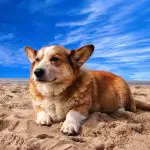Pug puppy and dog information
The Pug is an indoor dog as she dislikes cold or hot weather. She can do well in an apartment as long as she is walked for exercise. She is said to get along well with other pets, dogs and children. Cats can be a problem because they have prominent eyes and are prone to cat scratches. As a reminder, never leave a child unsupervised with a puppy or dog.
*Approximate Adult Size. The approximate adult size (two years old or older) of the male Pug is 12 to 14 inches to the withers (highest point of the shoulder) and 13 to 20 pounds. The female ranges from 10 to 12 inches to the withers and 13 to 18 pounds.
*Special Health Considerations. Most dog breeds have certain inherited health problems associated with that specific breed and the Pug is no exception. Be on the look out for breathing problems, heart disease, eye injuries and skin allergies. This disease list is an informative guideline only. Other diseases may also be significant threats, please contact your veterinarian for a complete list.
She should visit the veterinarian several times in the first year for shots, boosters and check up. Then, as an adult, she should visit the veterinarian yearly for shots and check up. As she gets older, six years and on, she should visit the veterinarian twice a year for check ups and shots. Remember; avoid feeding your dog sweets.
*Grooming. The Pug coat is smooth, fine, short and glossy. The face creases must be cleaned. She should be brushed regularly. Brushing will help her maintain a clean and healthy coat, avoid mats, help you keep a closer eye on her health and strengthen your emotional bond with her.
Her teeth should be brushed at least twice a week with toothpaste and toothbrush designed for dogs. Brushing removes the accumulation of plaque and tartar which can cause cavities (rarely) and periodontal disease. Dog periodontal disease can lead to pain, loss of teeth, bad breath and other serious disease.
Her toenails may need to be examined for growth and clipped regularly. The toenails of the rear feet grow slower than the toenails of the front feet.
*Life Span. The Pug can live between 12 and 14 years with proper nutrition, medical care and excellent living conditions.
*History. The Pug comes from China where they were used as a watch dog and companion. They were first registered by the American Kennel Association in 1885.
Some Registries: *Pug Dog Club of America *UKC United Kennel Club *NKC National Kennel Club *CKC Continental Kennel Club *APRI Americas Pet Registry Inc. *AKC American Kennel Club *FCI Federation Cynologique Internationale *NZKC New Zealand Kennel Club *KCGB = Kennel Club of Great Britain *ANKC = Australian National Kennel Club *ACR = American Canine Registry
Litter Size: 2 to 5 Pug puppies
Category: Toy
Terms To Describe: Loving, charming, stable, playful, even-tempered, affectionate, clever
*SPECIAL GOOD POINTS Some are watch dogs. Very friendly and good natured.
*SPECIAL BAD POINTS They tend to snore. Cats and pugs may not mix. Hard to train.
*Other Names Known By: Mops, Carlin,
*Every dog is an individual so not everything in this information may be correct for your dog. This information is meant as a good faith guideline only.


